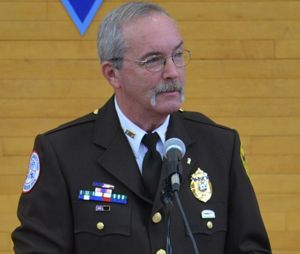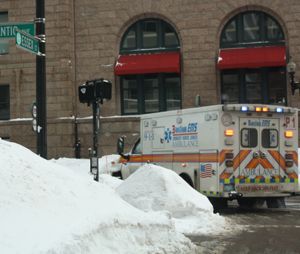Decades from now, when hardy New Englanders gather over pints of memory-restoring beverages to recall hardships endured, some Bostonian is sure to exclaim, “How about that blizzard of ’15?”
Memo to Massachusetts groupies: That will be a trick question. The correct response won’t be “Boy, that was something,” or even “Wicked cold,” but rather “Which blizzard of ’15?”
Nine storms between January 3rd and March 15th blanketed Boston with over nine feet of snow – a record – that buried cars, doorways, and even stadiums. From East Boston to West Roxbury, no one felt the frustration of trying to get from here to there more than the 350 EMTs and paramedics of Boston EMS (BEMS), the municipal agency charged with emergency care of the city’s 650,000 residents.
“It was just insanity,” says Joe O’Hare, Deputy Superintendent of BEMS and Commander of Dispatch Operations. “I’ve lived here my whole life and I’ve never seen anything like it.”
Digging out and digging In
O’Hare’s staff of 50 is responsible for dispatching BEMS’s fleet of 24 trucks, answering more than 120,000 911 calls annually, and managing hospital notifications across 61 cities and towns in eastern Massachusetts.
“We typically have five to seven EMTs plus a supervisor handling communications during each of our three shifts,” the 58-year-old paramedic says. “One or two of our people are dispatching at a time. With over 320 calls a day, it gets pretty stressful.”
O’Hare and his department had to deal with more than their customary ration of stress during the winter of ’15. Responding to other people’s emergencies is extra hard for EMS providers when impassable roads turn their daily commutes into polar expeditions.
“Our crews are regular people. Like everyone else, they had difficulty getting to work and getting home,” O’Hare says.
“Folks who’ve been here 16 hours just want their relief to walk through the door.”
 |
| Boston EMS Deputy Superintendent Joe O’Hare. (Image Boston EMS) |
Severe weather practices for operations continuity
Relief for snowbound crews was just one challenge during this year’s winter storms. O’Hare highlights seven bad-weather practices he and his department employed during 2015’s blizzard barrage:
1. Watch the weather
“Weather forecasts have gotten much better over the years. We tend to plan extra staffing and vehicles two to three days in advance of major storms.”
2. Wait for the aftermath
“We’ve learned not to overdo it during the storm itself. Our call volume stays steady or even drops during the actual event. At the height of a blizzard, people aren’t interested in leaving their homes unless they’re really sick. They’ll wait until that first ray of sunshine to call us.
“We don’t want to burn our folks out by having them work double shifts during the storm, then deal with a 10 to 20 percent rise in call volume right after.”
3. Be patient with your people
“We relax our rules about being late to work. If you’re a seven-o’clock guy and you get in at seven-thirty because there’s three feet of snow on the ground, we’re going to work around you. We’ll focus on trying to keep you warm and fed.
“It’s important to be flexible and provide some down time and a place to sleep for our crews. Their work is much more physical in this kind of weather.”
4. Know your special-needs patients
“We try to keep an up-to-date list of patients with life-sustaining devices like ventilators and LVADs (left ventricular assist devices). We can send someone to check on those folks after the power’s been out for a few hours.”
5. Be a lifeline for 911 callers
“Having experienced EMTs here is a big asset. When they’re giving CPR instructions to somebody on the phone, they know what it’s like. They can put themselves in the caller’s shoes. They’re really good at bridging the gap between the initial 9-1-1 call and EMS arrival.”
6. Prioritize assets and be honest with callers
“If you have two calls and one ambulance, who gets the ambulance: the 25-year-old with chest pain and no history or the 60-year-old with chest pain, hypertension and a prior MI? You might have to reroute the response from the first guy to the second.
“We don’t normally give our patients an ETA for an ambulance. When the roads get bad and response times get extended, we’ll tell callers with less-emergent conditions that we’ll send someone, but it’ll take time.”
7. Offer and accept mutual aid
“We work with surrounding private ambulance services for mutual aid. Patients who need dialysis, for example, need to go to the hospital or else they’re going to get really sick. We utilize the privates for some calls and they’ll give us some calls. We’re all in the same boat.”
 |
| Navigating snowbanks in downtown Boston. (Image Boston EMS) |
Crisis response starts well before severe weather event
The proficient Boston EMS response to the Marathon bombing highlighted the effectiveness of the agency. Leaders like Joe O’Hare continue to show how effective emergency management is rooted in anticipation and preparation.
“During crises, I think people revert to their training,” says O’Hare. “We give our people plenty of that. We bring everyone in monthly – nine months of the year – for a variety of topics. MCIs are part of that training right from the academy.
“With storms, we pre-deploy shovels, Skeds and extra blankets on every vehicle in advance of the weather. Our fleet services work extended hours to keep everything up and running. We work with universities and businesses to provide sheltered parking for our folks, and use SUVs to get them to their stations.
“It’s all about training and preparation.”
Those are two Boston staples as plentiful as snow.













